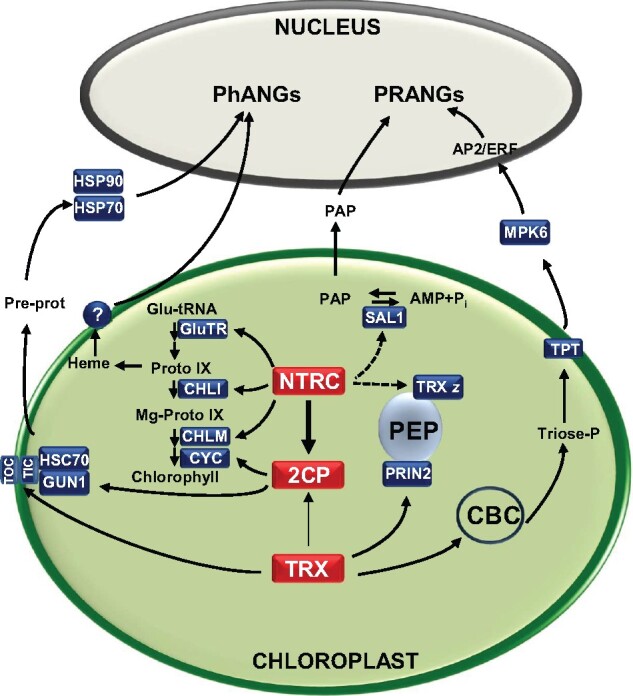Figure 3.

The chloroplast redox network may modulate retrograde signaling through several potential mechanisms. Retrograde signaling coordinates the activity of nuclear and plastid genomes during the process of chloroplast biogenesis (biogenic control), affecting the expression of PhANGs, and in mature chloroplasts in response to environmental cues (operational control), affecting PRANGs. The redox state of the chloroplast may constitute an additional layer of regulation that modulates biogenic and operational retrograde signaling. The NTRC–2-Cys PRX redox system controls tetrapyrrole biosynthesis enzymes such as GluTR, Mg-protoporphyrin IX methyltransferase (CHLM), the CHLI subunit of Mg-chelatase, and the Mg-protoporphyrin IX methylester cyclase (CYC). Biogenic retrograde signaling may thus be affected by the redox control of tetrapyrrole metabolism, as heme synthesis in the chloroplast promotes the expression of PhANGs. Import of pre-proteins (Pre-prot) may be affected by redox modifications of components of the translocons at the outer (TOC) and inner (TIC) chloroplast membranes or the interaction of 2-Cys PRX (2CP) with the GUN1–HSC70 complex, which triggers retrograde signaling mediated by cytosolic chaperones HSP90 and HSP70. Redox regulation of PEP-dependent transcription may be exerted by NTRC-dependent regulation of TRX z and PRIN2, which can also be regulated by TRXs. The redox state of phosphatase SAL1, which affects the levels of operational retrograde signal PAP, might be influenced by the NTRC–2-Cys PRX system. Operational retrograde signaling in response to high light mediated by kinase MPK6 and transcription factors APETALA2/ETHYLENE RESPONSE FACTOR (AP2/ERF) might be modulated by TRXs that regulate the Calvin–Benson cycle (CBC), the source of triose phosphate, which is translocated from the chloroplast via a TPT. Dashed arrows indicate indirect or putative interactions.
